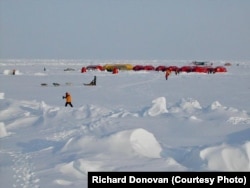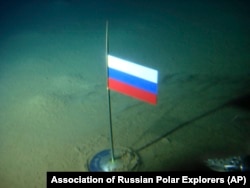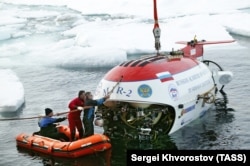On April 14, 2023, a Serbian man dressed in a black-and-gold-trimmed snowsuit stepped out onto the barren, snowy expanse at 90 degrees latitude north and joined in a circle dance with a group of about 20 Russian dignitaries and emergency workers.
The man was Srdjan Lolic, a little-known businessman who sat on the board of directors of a Belgrade hotel and now claimed to be the first Serbian to reach the North Pole. He traveled by way of the town of Khatanga, a tiny settlement on a peninsula at the northern tip of the sprawling Siberian region of Krasnoyarsk, and a seasonal ice camp known as Barneo that is controlled by a Swiss company.
A little less than three weeks earlier, Lolic was a lot farther south, driving around the suburbs of Milan in an Audi A8 sedan. His presence there, Italian prosecutors charge, was part of an audacious plot to help the businessman son of a Kremlin-decorated Russian governor escape from Italian-ordered house arrest requested by the U.S. Justice Department.
The businessman, Artyom Uss, had been indicted by the United States in September 2022 on charges of smuggling military technology to Russia, and prosecutors wanted him sent to the United States. His father, Aleksandr Uss, was the governor of the Krasnoyarsk region, where Russian officials have hoped to capitalize on demand from adventure tourists and scientists to travel to and explore the polar regions.
On June 14, 2024, Italian prosecutors announced the arrest of another person – a politically connected Russian businessman living in Switzerland – in connection with Uss’s escape from Italian house arrest.
According to video footage released by Russian state TV channels and the deputy governor for the Krasnoyarsk region, Lolic enjoyed himself at the North Pole, holding hands with the deputy governor as he danced. He later bragged about his trip in an interview with a Serbian tabloid, saying part of his journey had been on a military plane.
How Lolic, an unknown businessman with no history of polar exploration or no known history of Russian political or diplomatic ties, ended up as part of a Russian expedition to the North Pole remains shrouded in mystery. He did not respond to multiple e-mails. RFE/RL tried unsuccessfully to reach him via the Belgrade hotel where he served on the board until just two weeks before Uss’s escape.
But his North Pole journey is part of a twisting tale of Russian polar exploration in the post-Soviet era, a history that has drawn big egos, ambitious explorers, wealthy businessmen, and the Russian government.
The Italian Job
Artyom Uss’s escape from Italian house arrest was deeply embarrassing to Italian authorities. A businessman whose family had investments in hotels, real estate, and other assets, Uss was arrested as he departed the Milan airport the previous year, on October 17, 2022.
He was wanted on an arrest warrant by the U.S. Justice Department, which had indicted him, another Russian man, and several others as part of a scheme to smuggle dual-use technologies into Russia, evading Western sanctions. Some of that technology, U.S. prosecutors said, ended up in weaponry used in Russia’s war on Ukraine.
On March 22, 2023, the day after an Italian court approved his extradition, Uss disappeared from his villa on Milan’s southern outskirts, removing the court-ordered electronic monitoring bracelet. He reemerged publicly in Russia two weeks later.
Within months, Italian authorities announced criminal charges against six people accused of helping Uss escape. Three of those individuals are in police custody – in Croatia, in Italy, and in Slovenia; at least one is awaiting extradition to the United States. A seventh person, Dmitry Chirakadze, was arrested on June 14 by Italian police.
Lolic’s current whereabouts are unknown.
But on April 14, 2023 -- 22 days after Uss escaped -- he was at the North Pole.
He got there via Barneo.
'He Lost Control Of Barneo'
For decades, Soviet and Russian scientists, not to mention military planners, pioneered the use of floating bases, built on drifting sea ice, to maintain a presence in polar waters. Engineers used heavy cargo planes like Ilyushin-76s to lift in equipment like bulldozers and generators and machinery, clearing a runway, and setting up a small tent city. Smaller planes like Antonov-72s and Mi-8 helicopters ferry people in and out of various drifting bases.
Barneo ice station was one of the best known. Two French explorers, Bernard Buigues and Christian de Marliave, had patched together logistics and infrastructure in the 1990s, at a time when many Russian scientific organizations were nearly broke in the wake of the Soviet collapse. Buigues was credited with several major paleontological discoveries of woolly mammoths that had been frozen in Siberian permafrost.
In 2002, operations for Barneo were taken over by a Russian businessman and pilot named Aleksandr Orlov. The terms of the takeover were not entirely clear. One account, published on a blog dedicated to polar exploration, suggests it was not voluntary.
A biography of Swedish billionaire and polar adventurer Frederik Paulsen, who years later himself bought Barneo’s operations, also suggested Orlov’s takeover was hostile, and that Buigues had been physically threatened.
“‘I was told: You can save the mammoths, but don’t touch the North Pole anymore’,” Buigues was quoted as saying in the 2015 book, whose Russian version was released by Paulsen’s publishing house. “These were difficult times for young and still wild Russian capitalism, with the redistribution of property and tough, if not brutal, competition.”
“He lost control of the Barneo base,” the book said.
According to Paulsen’s book and other accounts by polar adventurers, the French men continued to work in the region, using some Russian resources, like helicopters, working in parallel with the Barneo operation.
In March 2005, however, their logistics support company, called Cerpolex, forced three polar expeditions to abort their treks prematurely. The cause, one of the expedition organizers wrote in a blog post, was “a dispute between logistics operators that led to a situation where the safety of the expedition(s) could no longer be guaranteed.”
Neither Buigues nor de Marliave could be reached for comment.
Royal Visitors And Seabed Politics
For nearly two decades, Barneo – set up every year during the few weeks around April that the winter ice was thick enough to hold heavy equipment – was the preeminent gateway for travelers heading to the North Pole: scientists, explorers, adventurers, even military troops. Russia’s Defense Ministry staged several highly publicized excursions to Barneo; one in 2016 included special forces units from Chechnya.
But most of the visitors to the site – located roughly 100 kilometers from the North Pole, depending on ice conditions – were tourists, the majority of whom were foreigners, according to one scientist who spent several seasons at Barneo in the late 2000s. And most of those foreign visitors traveled to the ice camp by way of Spitsbergen, an island on the Norwegian archipelago Svalbard.
In his 2023 memoir, Britain’s Prince Harry described traveling to Barneo during a charity trip to the North Pole. Monaco’s Prince Albert II also visited the camp in 2006. Some Russian business executives and political figures visited, including the current head of the powerful Federal Security Service.
In May 2017, Orlov died of a heart attack, just days after the completion of the season at the ice camp. Ownership passed to his widow, Irina, who oversaw the following year’s encampment, when hundreds of tourists flocked to the site.
In late 2018, Barneo was sold to Paulsen, who is the heir to a pharmaceutical company and has spent substantial amounts of money investing in polar adventures, not to mention tourist infrastructure in Russia. A new legal entity, Barneo LLC, was established, wholly owned by the Swiss company Barneo AG, controlled by Paulsen. The Barneo trademark was also reregistered to a Swiss legal entity Polar Holdings, also owned by Paulsen.
For his part, Paulsen had gained a measure of fame about a decade earlier. In 2007, two Russian Mir submersibles dove 4,261 meters to the bottom of the Arctic Sea and planted a titanium Russian flag on the seafloor as part of a Russian effort to stake claim to the seabed.
The incident was derided as an unserious stunt by some Western countries, but hailed as a triumph within Russia.
The primary sub carried a famed Russian explorer named Artur Chilingarov, who headed the Russian Geographical Society and was later awarded a medal by President Vladimir Putin for the flag-planting. Chilingarov died on June 1, 2024.
The other sub carried Paulsen, who paid $1.5 million for the experience of traveling to the sea bottom. The following year, he was honored with a medal bestowed by Putin personally. He was also made a board member of the Russian Geographical Society, and in 2008 he was named honorary consul for Russia in the Swiss city of Lausanne.
'Whoever Said The North Pole Was Simple?'
In recent years, a confluence of events has made Barneo operations impossible: climate change and warmer polar temperatures, COVID-19 restrictions, Russia’s all-out invasion of Ukraine in 2022, Western sanctions.
In 2019, the ice camp failed to open for the first time since 2002, amid a dispute over the use of Ukrainian Antonov aircraft.
The uncertainty has squeezed Barneo and Russian polar tourism more broadly, even as the Kremlin pours money into its northern regions to try and capitalize on the thawing northern environment.
Paulsen, meanwhile, pushed forward with his investments. He had already invested in a publishing house specializing in Russian-language books about the Arctic and Antarctic, and built a handful of fertility clinics.
In April 2021, he traveled to the capital of Krasnoyarsk, meeting with the then-governor, Aleksandr Uss, who has boasted publicly of his friendship with Putin. Uss and Paulsen discussed developing a direct route to the North Pole via Khatanga, a government news release said.
Paulsen invested in the reconstruction and rebranding of a worn-out hotel in Khatanga – now called Mamont Inn, a reference to the Russian word for mammoth. He also bought an An-74 aircraft to fly tourists and others to Barneo, according to the press release. For several years, his company has produced a line of high-end Russian vodkas, also called Mamont.
Paulsen did not respond to e-mails sent to his company, his charitable endeavors, and RFE/RL could not reach the head of Barneo AG, the company that owns the ice camp.
A Russian-language social media post by Paulsen’s publishing company on May 14 describes some of Barneo history and the recent problems the camp has had.
“Frederik Paulsen has invested heavily in maintaining the company over the years, he believes in his business and is not ready to give up. He decides that in the current situation it is necessary to transfer all activity to Russia,” the post on the Russian social media site VK said, before describing Paulsen’s investment in Khatanga.
“Paulsen's company is trying to resolve all issues – from visa support to issuing temporary bank cards that tourists can use to pay here,” the post said. “But whoever said, and when, that the North Pole was simple?”
Enter The Serb
On March 16, 2023, as Barneo was preparing to open for the season, Norwegian authorities refused permission for Antonov planes to utilize the Svalbard airspace to fly in and out of Barneo, citing environmental concerns. The move made it all but impossible for Barneo to open for full operations.
A week later, about 3,700 kilometers to the southwest of Svalbard, Artyom Uss escaped from Italian house arrest.
In Serbia, Srdjan Lolic was a little-known, 51-year-old businessman who until February 9, 2023, sat on the executive board of a Belgrade hotel called Putnik Inn. He has a limited public profile on social media, and there is no public indication that he was a polar adventurer or even interested in extreme sports or travel.
But in a series of social media posts by a pro-Russian parliamentarian in Montenegro on April 14, 2023, Lolic was shown visiting Russian polar regions. In one, he’s shown standing in front of an An-72, registered to a military transport unit based at the southern Russian city of Tver, on an ice runway in what appears to be the Barneo ice camp.
“This is the first Serb in history to raise the Serbian flag at the North Pole. Hats off, Srdjan!” the lawmaker, Vladislav Dajkovic, wrote in the caption to the photo.
In a series of other photos and videos published by Sergei Ponomarenko, the deputy governor of Krasnoyarsk, Lolic can be seen dancing in a circle, along with a group of other visitors, some from a charter air company, some from Russia’s Emergency Situations Ministry, some from an air charter company. Lolic is holding Ponamarenko’s hand as the group dances; in another video, published by Russian state television, Lolic is shown briefly along with a group of people holding up various flags, including one dedicated to the Siberian Fire and Rescue Academy.
A news release issued by the academy said its delegation traveled “more than 4,000 kilometers” from Khatanga to the Cape Baranov base on the Severnaya Zemlya archipelago: “The next stop was the drifting camp of the Barneo Expedition Center of the Russian Geographical Society, then by helicopter we went to the North Pole itself, where the flag was raised in a solemn atmosphere.”
Weeks later, in an interview with the Srpski Telegraf tabloid, Lolic described his journey:
“Since I consider myself a patriot, and that was one of the main reasons for me to embark on the expedition, I brought out the Serbian flag and placed it at 90 degrees north,” he said. “In this way, I wanted to present our country to the whole world. So it was an honor for me to represent Serbia as a man and an adventurer.”
Lolic said that upon returning from the north, he flew to Krasnoyarsk’s capital, and dined and attended Orthodox Church services with Aleksandr Uss, whom U.S. authorities call Putin’s "close ally" and who announced his resignation as Krasnoyarsk governor five days after the interview with Lolic was published. He is now a lawmaker in Russia’s upper house of parliament.
Lolic could not be reached for comment, and his current whereabouts are unclear.














